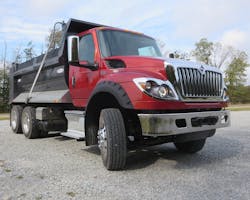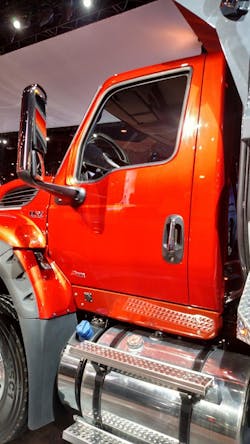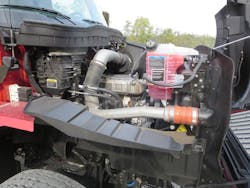International HV is Newer Than It Looks
What is this: an International WorkStar or a new HV model? You could say it’s both, because the HV (for Heavy Vocational) incorporates the outgoing WorkStar’s familiar hood and basic cab with re-engineered doors, new interior, and chassis updates. Regular drivers will probably like the interior better because it’s more truck-like in appearance than the WorkStar’s automotive design, and gauge legibility and various controls are redone for better legibility and functionality.
International NV Test Set
Truck: 2018 International HV613 daycab construction dump, setback steer axle, BBC 113 in., frame rails w/ outer C-channels, GVW 58,000 lb.
Engine: 12.4-liter (758-cu-in.) Navistar A26, EPA 2017, 475 hp @ 1,700 rpm, 1,700 lb.-ft. @ 1,000 rpm, governed speed 2,100 rpm
Transmission: Allison 4500RDS (rugged duty series) torque-converter automatic, 6-speed double-overdrive
Front axle: 18,000-lb. Meritor MFS-18-133A on steel parabolic taperleafs, w/ Sheppard M100/M80 dual hydraulic power steering
Rear axles: 40,000-lb. Meritor MT-40-14X-4DFR, 5.29 ratio, on Hendrickson HAS-42-55 (40K-lb. capacity, 55-inch axle spacing) 4-bag air-ride
Brakes: Meritor S-cam drums
Wheelbase: 197 in.
Tires & wheels: Front, 315/80R22.5 Continental HSC1; rear, 275/80R22.5 Michelin XDE, on Accuride polished aluminum discs
Fuel tank: 80-gal. polished aluminum
Body: 15-ft. Ledwell 12/14-yd. steel tub dump
Navistar International has been introducing freshened products and new model names over the past year, starting with the aluminum-cab HX (for Heavy eXtreme), a premium vocational model which has replaced the PayStar. Then came steel-cab models: LT (for Linehaul Transport), replacing the ProStar; RH (Regional Haul), replacing the TranStar; and now the HV, which will supersede the WorkStar. The medium-duty DuraStar will become the MV (Medium Vocational) this spring. A prime focus for all models, Navistar people say, is driver-pleasing details, especially inside the cab. Driving the HV and other International models shows me that they’re serious about catering to drivers and helping owners attract and retain good ones.
Steel cabs were improved and updated as part of Navistar’s Project Horizon, a multi-year effort by engineers and designers. With input from customers and drivers, they created the new interiors and reshaped doors for improved visibility and better sealing against noise. Window sills are lower and glass larger for a commanding view to the sides. The vent windows have been eliminated, allowing the repositioning of mirror mounts a little forward. This results in 15 percent less head turning to the left and 5 percent less to the right, easing a driver’s neck twisting, Navistar executives said during the HV’s unveiling last September at the North American Commercial Vehicle Show in Atlanta.
After the briefings we were bussed out to the driving areas: the 2.5-mile high-speed oval with a central pad, where several on-road models were available for tryouts, and the off-road course with various paved and gravel surfaces. For off-road testing, several trucks and one tractor (an HX with a newly available integral sleeper) were lined up. I drove many of them, but for this article sought out the red dump truck, which was the same one displayed at the Atlanta show. Did I say “red”? The color is actually called “sunrise orange pearl,” not to be confused with undesirable “orange peel,” in auto body talk, because the paint on this truck was smooth and glossy. It’s eye catching, for sure.
I had to wait a while for the HV. But when I had it, I hogged it to get as much wheel time as possible. The sprawling grounds, originally built by the old Studebaker Corp. in the mid-1920s, allows simulated running on highways and trails, but not work sites or urban streets on which dump trucks, mixers, and the like spend a lot of their time. Still, it’s an almost risk-free place for a truck builder to allow guests to sample its products. And on the off-road course, there are enough tight turns to test maneuverability, which was very good on this HV 10-wheeler. I ran the off-road course four times, taking it slow over the most severe rough spots, but still observing considerable shaking of the cab and dashboard—to be expected, it seemed to me. And I got on the gas where there was room to run.
The A26 is Navistar’s latest diesel and one based on the European MAN D26. It’s a 12.4-liter inline 6-cylinder model with the latest in air-handling, combustion, exhaust aftertreatment, and electronic controls. Navistar says it’s simpler than the discontinued MaxxForce 13 and the N13 it will replace. The A26 uses a single variable geometry turbocharger and one EGR cooler instead of the MaxxForce’s double turbos and coolers; it also places items needing common maintenance in easier-to-access locations, execs said.
The A26, with up to 475 horsepower and 1,750 lb.-ft. of torque, is Navistar’s preferred engine on heavier HVs, while the 8.9-liter Cummins L9 is available for weight-sensitive applications, such as mixers. Cummins’ B6.7 will be used in lighter models. Navistar people emphasize the “valuable” partnership with Cummins, which supplies those engines and the heavy X15, and whose exhaust aftertreatment equipment Navistar began using when its all-EGR approach for MaxxForce motors failed. But Navistar is not listing Cummins’ lightweight X12 diesel as an option in the HV or any other heavy-duty truck model; neither are competitors because, while they all offer the X15 and the smaller Cummins diesels, they’d rather sell their own 11- and 13-liter-class engines. And Navistar’s alliance with Volkswagen Truck & Bus suggests more proprietary engines and fewer products from Cummins. That’s business.
Even so, an HV can be highly customized to suit any job. It can be had with three cab styles, “super single” frame rails as thick as one-half inch, and integral forward frame extensions for mounting special equipment ahead of the grille. For really rough-terrain operation, a 20,000-pound front-driving axle with an offset bowl allows the chassis to sit lower than with a centered differential. Many axle types and capacities are in the data book. Our test truck had an Allison 4500RDS fully automatic transmission, and Navistar also offers Eaton manual and automated gearboxes for the HV. Self-shifting trannies are controlled by a stalk selector, on the right side of the steering column. It’s easy and convenient to use.
By the way, you can “paint” a truck in something similar to sunrise orange pearl on a section of www.InternationalTrucks.com called Build Your Own HV Series. By clicking on buttons, you can configure a truck for various applications, including “construction dump,” “construction crane,” and “cement mixer” (yes, it should be “concrete”). For some reason, only single-rear-axle chassis show, though I did stumble on one tandem, then lost it. Anyway, you see the various 500 and 600 subseries, denoting hood length and steer-axle placement, within the HV lineup. The website is worth a look, and even more worthwhile will be an actual look and drive of an HV, which should be at dealers early this year.



